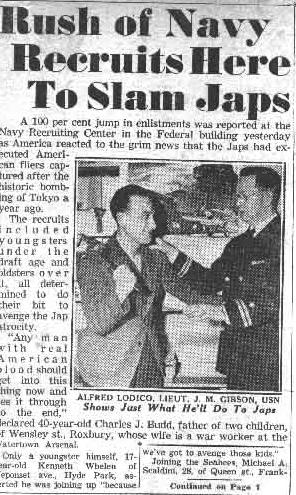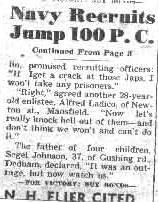

Doolittle Raid on Japan, 18 April 1942
At dawn on April 18, 1942, less than five months after the Japanese attack on Pearl Harbor, Hawaii, U.S. Navy Task Force 16 was steaming through violent Pacific waters toward Japan. The flotilla consisted of two actual task forces, task forces 16.2 and 16.1. Task force 16.2 was built around the USS Hornet, an aircraft carrier with the unlikely cargo of sixteen Army Air Corps, North American B-25s, and their crews. The cruisers Nashville, and Vincennes as well as the oiler Cimarron and the destroyers Gwin, Meredith, Grayson, and Monssen complimented the Hornet. US Navy Captain Marc Mitscher commanded the taskforce while Army Air Corps Lieutenant Colonel James "Jimmy" H. Doolittle was in command of the sixteen aircrews. Task force 16.1 was built around the carrier USS Enterprise and served as an escort for the Hornet. It included the cruisers Northampton and Salt Lake City, the oiler Sabine and the destroyers Balch, Benham, Ellet and Fanning. Admiral William F. Halsey commanded.
The first B-25 was launched at 8:25 a.m., six hundred twenty-five miles from Japan, with Col. Jimmy Doolittle at the controls. All sixteen B-25s made it safely off the deck, although injuring one ships crewman who had fallen into one of the planes propellers. They all reached the Japanese islands, dropped their bombs on oil stores, factory areas, and military installations, and then headed out across the East China Sea. However, night was approaching, and the B-25s began running low on fuel, not to mention the fact that the weather was rapidly deteriorating. The crews realized they could not reach the Chinese airfields. They were forced to bail out, ditch at sea, or crash-land, although one plane was able to divert to Vladivostok, Russia.
Following the Doolittle Raid, many of the crews were forced into hiding in Japanese occupied China. Only through the help of several friendly Chinese were some of the crews able to escape to "Free China". On Aug. 15, 1942. It was learned from the Swiss Consulate General in Shanghai that eight American flyers were prisoners of the Japanese Police in that city.
After the war, the facts were uncovered in a War Crimes Trial held at Shanghai, which opened in Feb. 1946 to try four Japanese officers for mistreatment of the eight POWs of the Tokyo Raid. Two of the original ten men, Dieter and Fitzmaurice, had died when their B-25 ditched off the coast of China. The other eight, Hallmark, Meder, Nielsen, Farrow, Hite, Barr, Spatz, and DeShazer were captured. In addition to being tortured, they contracted dysentery and beriberi as a result of the deplorable conditions under which they were confined.
On Aug. 28, 1942, Hallmark, Farrow, and Spatz were given a "trial" by Japanese officers, although they were never told the charges against them. On Oct. 14, 1942, Hallmark, Farrow, and Spatz were advised they were to be executed the next day. At 4:30 p.m. on Oct. 15, 1942 the three Americans were brought by truck to Public Cemetery No. 1 outside Shanghai. In accordance with proper ceremonial procedures of the Japanese military, they were then shot.
On October 19, 1942, the Japanese broadcast that two of Doolittle's crews had been put on trial for supposed war crimes, and had been sentenced to death. Soon after they reported that a small number had been executed and that the remainder had been sentenced to life imprisonment.
The resultant broadcast swept across America and a rush of new recruits flooded draft offices.
My father, Alfred G. LoDico, age 28, was one of those who enlisted when the age restrictions were dropped.

